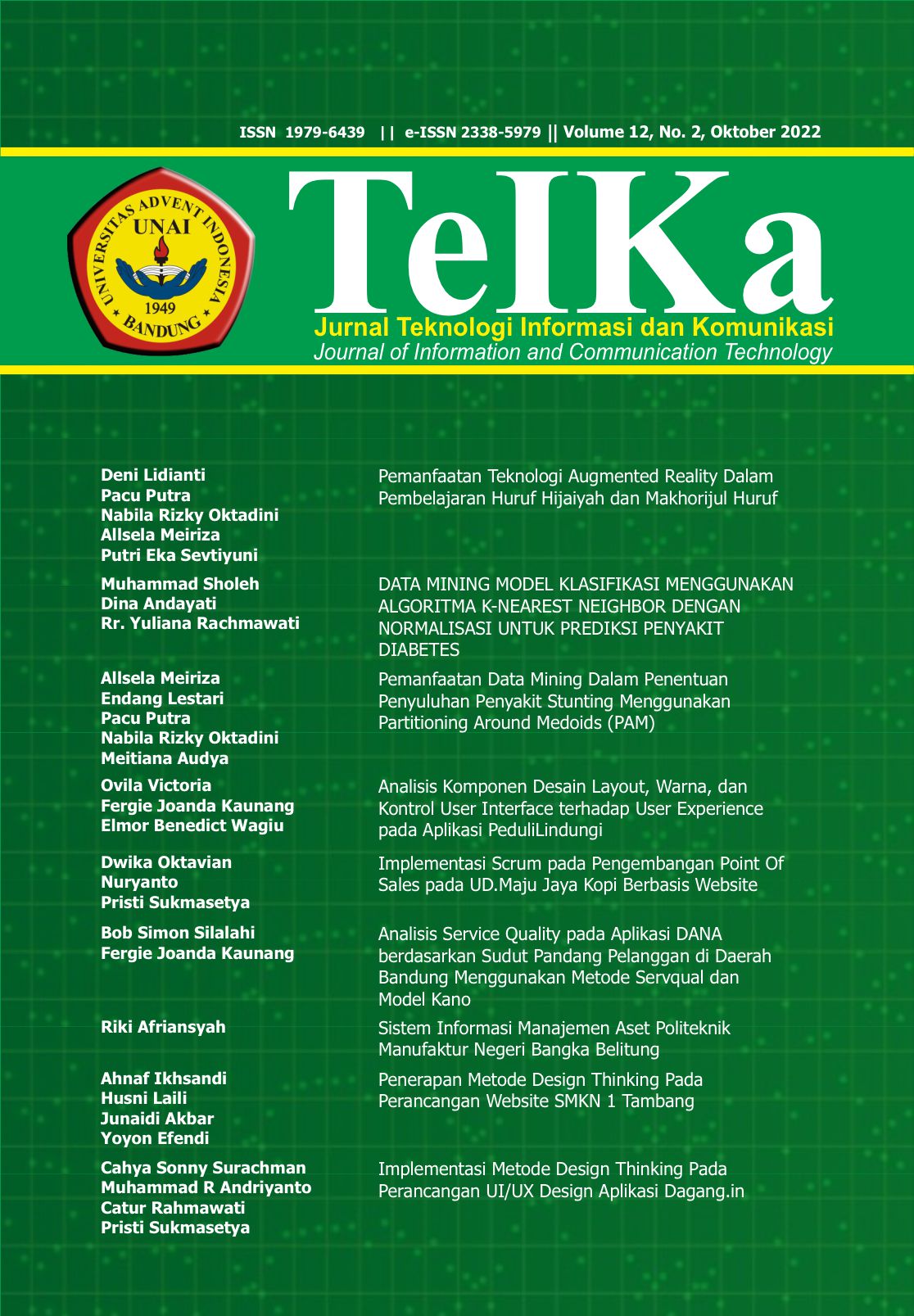PPID Magelang City Website-Based User Interface Design Using User Centered Design (USD) Approach
Keywords:
PPID Kota Magelang, User Interface, User Centered Design, DesignAbstract
Website portals are one of the important role of the internet in disseminating information for the government. However, the development of existing website portals is often focused on goals without involving Users in using the portal. Therefore, this study aims to provide a website-based PPID Magelang City User interface design to accommodate User needs. The approach used is User Centered Design (UCD). This approach was chosen considering that in the UCD approach Users are directly involved as the main basis for the system development process. The best results from this research will then be used as the main data in the process of making the best interface design. With the involvement of active potential Users, it will make the decision-making process in design implementation more effective. In addition, the results of this study provide a user interface design that makes it easier for Users to find information needs in PPID Magelang City without changing the substantion that has been used.
Downloads
References
I. U. Khasanah, M. Fachry, N. S. Adriani, N. Defiani, Y. Saputra, and A. Ibrahim, “Penerapan Metode User Centered Design dalam Menganalisis User Interface pada Website Universitas Sriwijaya,” INTEGER J. Inf. Technol., vol. 3, no. 2, pp. 21–27, 2018, doi: 10.31284/j.integer.2018.v3i2.226.
N. Hadiningrat, “in the Kapustakan System Using User Centred Design,” pp. 37–48, 2019.
A. Tirtana, H. N. Hadi, and A. Zulkarnain, “Penggunaan User Centered Design Dalam Pembuatan Website Portal Mgbk Sma Kota Malang,” J. Teknoinfo, vol. 16, no. 1, p. 138, 2022, doi: 10.33365/jti.v16i1.1358.
I. Rochmawati, “Iwearup.Com User Interface Analysis,” Visualita, vol. 7, no. 2, pp. 31–44, 2019, doi: 10.33375/vslt.v7i2.1459.
E. Rahmawati and N. Ningsih, “Perancangan Desain UI/UX untuk Aplikasi Sewa Sawah Online Di Desa Tanjungsari Kabupaten Jember Menggunakan Metode User Centered Design (UCD),” Spirit, vol. 13, no. 1, pp. 17–27, 2021, doi: 10.53567/spirit.v13i1.196.
R. D. Cahyani and A. D. Indriyanti, “Penerapan Metode User Centered Design dalam Perancangan Ulang Desain Website MAN 1 Pasuruan,” JEISBI (Journal Emerg. Inf. Syst. Bus. Intell., vol. 03, no. 02, pp. 40–48, 2022.
C. E. Zen, S. Namira, and T. Rahayu, “Rancang Ulang Desain UI (User Interface) Company Profile Berbasis Website Menggunakan Metode UCD (User Centered Design),” Semin. Nas. Mhs. Ilmu Komput. dan Apl., no. April, pp. 17–26, 2022.
F. Natsir and R. A. Sihombing, “Penerapan Metode User Centered Design pada Rancangan User Interface Marketplace Pemasaran Produk Olahan Perikanan,” J. Pract. Comput. Sci., vol. 2, no. 2, pp. 56–63, 2022, doi: 10.37366/jpcs.v2i2.1472.
S. Rahayu and Y. Mz, “SISTEM REKOMENDASI SET ALAT PANCING BERDASARKAN LOKASI MEMANCING MENGGUNAKAN METODE CERTAINTY FACTOR DAN USER CENTERED DESIGN ( UCD ),” vol. 11, no. 1, pp. 44–55, 2023.
M. Ikhsan and P. Sukmasetya, “Perancangan User Interface Aplikasi Central Islam Berbasis Mobile Application dengan Metode User Centered Design (UCD),” Seri Pros. Semin. …, pp. 97–103, 2020, [Online]. Available: http://prosiding.senadi.upy.ac.id/index.php/senadi/article/view/135
M. A. Setiawan and A. A. Permana, “Analisis Dan Perancangan Ui/Ux Website Pada Cv Samudera Biru Nusantara Dengan Metode User Centered Design (Ucd),” J. Tek., vol. 12, no. 01, pp. 1–9, 2023, [Online]. Available: https://jurnal.umt.ac.id/index.php/jt/article/view/7577
M. S. Victoria and A. D. Indriyanti, “Penerapan Metode User Centered Design ( UCD ) dalam Merancang User Interface Learning Management System Website Torche Education,” vol. 04, no. 03, pp. 157–167, 2023.
M. Prabowo and A. Suprapto, “Usability Testing pada Sistem Informasi Akademik IAIN Salatiga Mengunakan Metode System Usability Scale,” JISKA (Jurnal Inform. Sunan Kalijaga), vol. 6, no. 1, pp. 38–49, 2021, doi: 10.14421/jiska.2021.61-05.
Downloads
Published
How to Cite
Issue
Section
License
Copyright (c) 2023 TeIKa

This work is licensed under a Creative Commons Attribution-ShareAlike 4.0 International License.
The submitting author warrants that the submission is original and that she/he is the author of the submission together with the named co-authors; to the extend the submission incorporates text passages, figures, data or other material from the work of others, the submitting author has obtained any necessary permission.
Articles in this journal are published under the Creative Commons Share Alike Attribution Licence (CC-BY-SA What does this mean?). This is to get more legal certainty about what readers can do with published articles, and thus a wider dissemination and archiving, which in turn makes publishing with this journal more valuable for you, the authors.
By submitting an article the author grants to this journal the non-exclusive right to publish it. The author retains the copyright and the publishing rights for his article without any restrictions.










